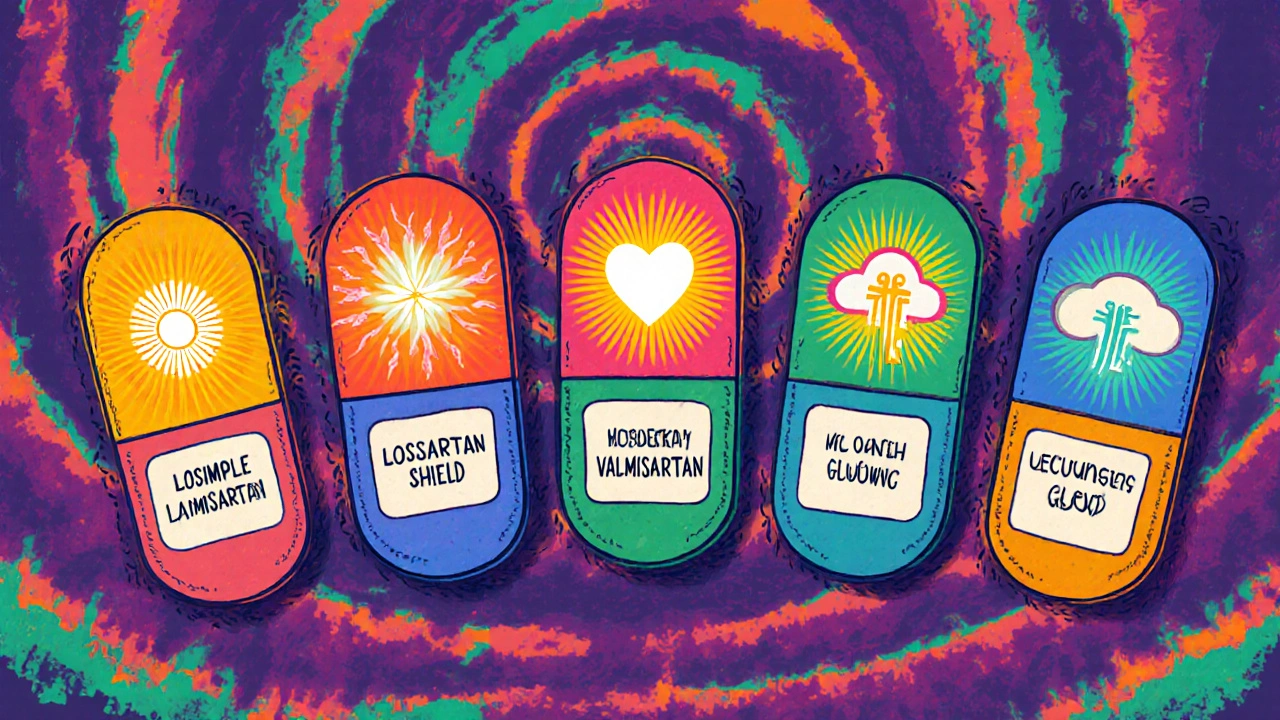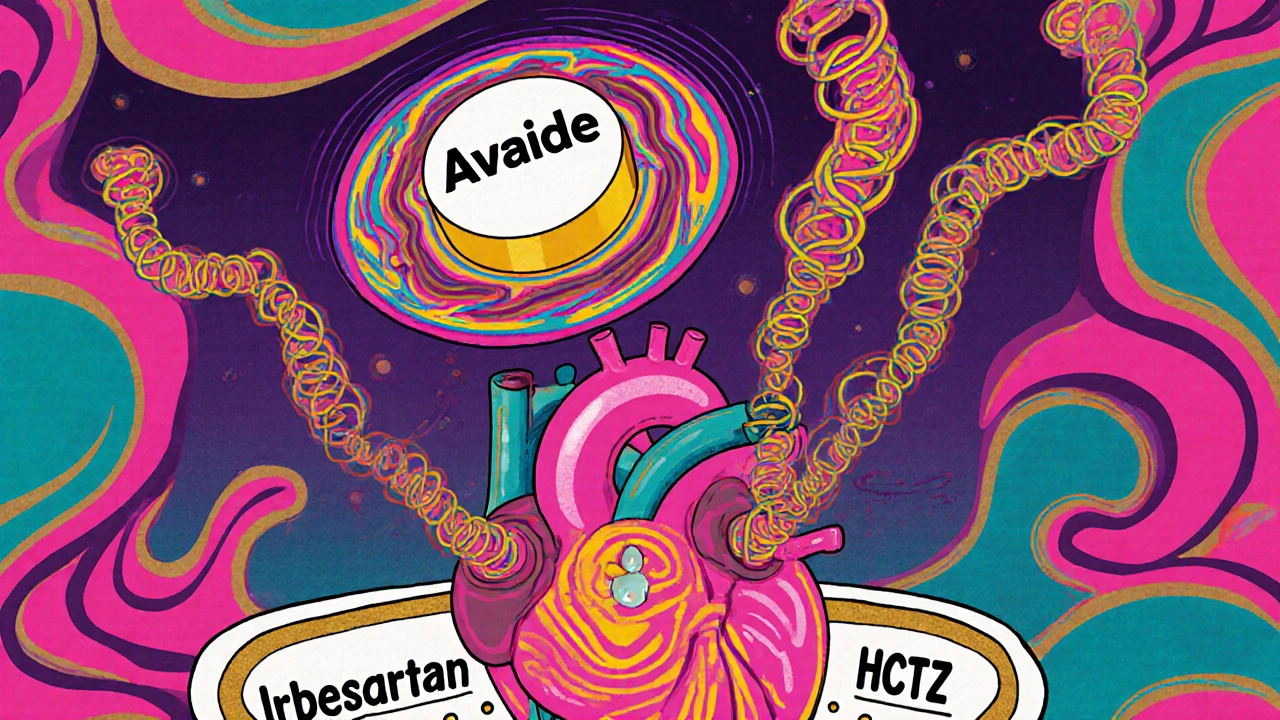High blood pressure doesn’t care if you’re busy, tired, or stressed. It just keeps climbing. If you’ve been prescribed Avalide (irbesartan), you’re not alone. Millions use it to keep their numbers in check. But maybe you’re wondering: is this really the best option? Are there better, cheaper, or safer alternatives? You’re not just shopping around-you’re trying to find what fits your life.
What Avalide Actually Does
Avalide is a combo drug: irbesartan + hydrochlorothiazide. Irbesartan is an ARB-angiotensin II receptor blocker. It works by blocking a hormone that tightens blood vessels. When that hormone can’t do its job, vessels relax. Blood pressure drops. The hydrochlorothiazide part is a diuretic. It helps your kidneys flush out extra salt and water. Less fluid in your system = lower pressure.
This combo is often prescribed when one drug alone isn’t enough. It’s not a first-line choice for everyone, but it’s common for people with stage 2 hypertension or those who haven’t responded to single-agent therapy. Studies show it lowers systolic pressure by 15-20 mmHg on average, which is solid for a combo pill.
How It Compares to Other ARBs
Irbesartan isn’t the only ARB on the market. Others include losartan, valsartan, candesartan, and telmisartan. They all work the same basic way-blocking angiotensin II. But they’re not identical.
- Losartan is older and cheaper. Many generics are under $5 a month. But it’s less potent per milligram. You might need higher doses to match irbesartan’s effect.
- Valsartan has more data supporting heart protection after heart attacks. If you’ve had cardiac issues, your doctor might lean toward this.
- Telmisartan has a longer half-life. That means once-daily dosing is more reliable, even if you miss a pill by a few hours. It also has some evidence for improving insulin sensitivity, which helps if you’re prediabetic.
- Candesartan is often used when patients can’t tolerate ACE inhibitors due to cough. It’s similar to irbesartan in strength but has fewer studies on long-term kidney protection in diabetics.
Irbesartan stands out because of its strong kidney-protective effects in people with type 2 diabetes. A 2001 study published in the New England Journal of Medicine showed it reduced kidney damage by 20% over 2 years compared to placebo. That’s why it’s often chosen for diabetic patients with high blood pressure.
Avalide vs. ACE Inhibitors
Many people start with ACE inhibitors like lisinopril or enalapril. They’re cheaper, widely used, and effective. But they come with a common side effect: a dry, hacking cough. About 10-20% of users get it. It’s not dangerous, but it’s annoying enough that many quit the drug.
Avalide doesn’t cause that cough. That’s a big reason doctors switch patients from ACE inhibitors to ARBs like irbesartan. If you’ve tried lisinopril and stopped because of cough, Avalide is likely your next step.
But ACE inhibitors have one edge: they’re proven to reduce mortality in heart failure patients. If you have heart failure, an ACE inhibitor might still be preferred-unless you can’t tolerate it.
Other Combination Options
Avalide isn’t the only combo pill. There are others that mix different classes:
- Benicar HCT (olmesartan + hydrochlorothiazide): Similar to Avalide. Olmesartan is slightly more potent per mg, but studies show nearly identical blood pressure control.
- Atacand HCT (candesartan + HCTZ): Good for patients needing strong, long-lasting control. Less commonly prescribed than Avalide.
- Amturnide (aliskiren + amlodipine + hydrochlorothiazide): A three-drug combo. Used for resistant hypertension. More expensive. Not a direct substitute unless you’re already on multiple meds.
- Exforge (amlodipine + valsartan): Combines a calcium channel blocker with an ARB. Often used when diuretics aren’t enough or cause electrolyte issues.
Most of these combos are priced similarly to Avalide. Generic versions of all of them are available, so cost isn’t usually the deciding factor. What matters more is side effects and how your body responds.

What About Single-Drug Alternatives?
If you’re on Avalide but want to simplify, you might consider switching to a single-agent ARB or another class entirely.
- Calcium channel blockers like amlodipine or diltiazem work differently. They relax artery walls directly. They’re great for older adults and Black patients, who often respond better to these than ARBs. Side effects? Swollen ankles, flushing, dizziness.
- Thiazide diuretics alone like hydrochlorothiazide (without irbesartan) are still first-line for many. They’re cheap and effective. But they don’t offer the same kidney protection as ARBs.
- Beta-blockers like metoprolol are rarely used as first-line anymore. They’re more for heart rate control or after heart attacks. Not ideal for pure hypertension unless you have other conditions.
One study from the Journal of the American College of Cardiology in 2023 showed that in patients over 60, amlodipine lowered systolic pressure just as well as irbesartan-but with fewer reports of dizziness or fatigue. That’s important if you drive or work with machinery.
Side Effects: What to Watch For
All blood pressure meds have trade-offs. Avalide’s most common side effects are dizziness, low blood pressure (especially when standing up), and increased potassium levels. You’ll need regular blood tests to check your potassium and kidney function.
Some people get muscle cramps or feel dehydrated because of the diuretic. Drink water, but don’t overdo it. Too much water can dilute your sodium and cause problems.
ARBs like irbesartan are generally safer than ACE inhibitors for the kidneys and don’t cause cough. But they can raise potassium-especially in people with kidney disease or those taking NSAIDs like ibuprofen. Avoid ibuprofen if you’re on Avalide. Use acetaminophen instead for pain.
When to Consider Switching
You don’t need to switch just because you’re on Avalide. But here are signs it might be time:
- Your blood pressure is still high (above 130/80) on the highest dose.
- You’re experiencing side effects that affect your daily life-dizziness, fatigue, frequent urination at night.
- You’re taking other meds that interact with hydrochlorothiazide (like lithium or digoxin).
- Your doctor says your potassium is too high or your kidneys are showing signs of strain.
- You’re paying too much and can’t afford generics.
If any of these apply, talk to your doctor. Don’t stop or switch on your own. Blood pressure can rebound dangerously if you quit cold turkey.
Cost and Accessibility
Generic irbesartan/hydrochlorothiazide costs about $10-$20 a month at most U.S. pharmacies with a GoodRx coupon. That’s cheaper than many brand-name ARBs and on par with other combo pills.
Losartan/HCTZ is often under $5. If cost is your biggest concern and you don’t have diabetes or kidney disease, that’s a solid alternative.
Some insurance plans still favor certain brands. Check your formulary. Sometimes switching to a different combo pill gets you better coverage-even if the drug is similar.
Final Thoughts: What’s Right for You?
There’s no single “best” blood pressure pill. The right one is the one that works for you-with minimal side effects, affordable cost, and consistent results.
If you have diabetes or kidney disease, Avalide (irbesartan) is still one of the top choices because of its proven kidney protection. If you had a cough from an ACE inhibitor, Avalide is a logical next step.
If you’re older, African American, or have swelling in your legs, a calcium channel blocker might work better. If money is tight and you don’t have organ damage, losartan/HCTZ is a great budget option.
Track your blood pressure at home. Take notes. Bring them to your doctor. Your response to the drug matters more than what’s on a list. What works for your neighbor might not work for you. And that’s okay.
Is Avalide the same as irbesartan?
No. Avalide is a brand-name combo drug that contains irbesartan plus hydrochlorothiazide. Irbesartan is just one of the two active ingredients. You can buy irbesartan alone as a generic, but that won’t have the diuretic effect. If your doctor prescribed Avalide, they wanted both drugs working together.
Can I switch from Avalide to losartan on my own?
No. Never stop or switch blood pressure meds without talking to your doctor. Even if losartan seems cheaper or similar, your body may respond differently. Stopping suddenly can cause your blood pressure to spike, raising your risk of stroke or heart attack. Your doctor will guide a safe transition, often by gradually reducing one drug while adding the other.
Does Avalide cause weight gain?
Not directly. But the hydrochlorothiazide component can cause you to lose water weight at first, which might make you feel lighter. Over time, some people gain weight due to increased appetite or fluid retention from other factors. If you notice unexplained weight gain, check your sodium intake, kidney function, and whether you’re retaining fluid. Talk to your doctor before assuming it’s the medication.
How long does it take for Avalide to work?
You might see a drop in blood pressure within a week, but it usually takes 2 to 4 weeks for the full effect. Don’t expect instant results. Consistency matters more than timing. Take it at the same time every day, even if you feel fine.
Is there a natural alternative to Avalide?
No natural remedy can replace Avalide for treating moderate to severe hypertension. Some supplements like magnesium, potassium, or beetroot juice may help lower blood pressure slightly, but they’re not strong enough to replace prescription meds. Relying on them alone can be dangerous. Lifestyle changes-like reducing salt, losing weight, and exercising-are powerful supports, but they usually work best alongside medication, not instead of it.
Next Steps
Write down your blood pressure readings for a week. Note any side effects-dizziness, fatigue, cramps, frequent urination. Bring this list to your next appointment. Ask: “Is there a reason I’m on Avalide instead of another ARB or combo?” “Are there cheaper generics that would work just as well?” “Should I test my potassium or kidney function?”
Most people find their best fit after trying one or two options. It’s not about finding the perfect drug. It’s about finding the one that lets you live without constant worry, side effects, or surprise trips to the ER. Your body will tell you what it needs. You just have to listen-and talk to your doctor about it.

Dana Dolan
November 20, 2025 AT 01:40I’ve been on Avalide for 3 years now and honestly? It’s been a game-changer. No cough, no dizziness, just steady numbers. I used to take lisinopril and that dry cough had me sounding like a dying seal at 3 a.m. Switching was the best decision I ever made.
Also, side note: I drink way more water now and it helps. Not too much, not too little. Just enough to not feel like a raisin by noon.